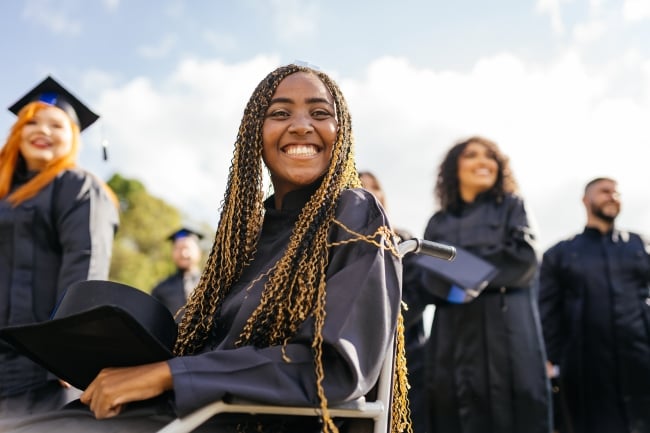You have /5 articles left.
Sign up for a free account or log in.

To support students with disabilities in earning a postsecondary credential or degree, disability services officers and higher education practitioners can help educate students on accessing accommodations.
Igor Alecsander/E+/Getty Images
The number of students with disabilities has grown 10 percentage points since 2004 to 21 percent of all learners, with large increases in students who have depression (27 percent); a mental, emotional or psychiatric condition (21 percent); and attention deficit disorder (21 percent), according to a May report from the U.S. Government Accountability Office.
However, students with disabilities were less likely to graduate from college than their peers (21 percent, compared to 38 percent) and, among those who did complete, they were less likely to be employed full-time compared to their peers.
To better support these learners, researchers conducted interviews with staff in disability services offices, students with disabilities and faculty members to understand the most prevalent barriers to student success and some of the solutions institutions are implementing.
Methodology
In compiling the report, researchers analyzed data from the Department of Education’s National Postsecondary Student Aid Study, Beginning Postsecondary Students Longitudinal Study and Baccalaureate and Beyond Longitudinal Study.
Researchers also spoke with college students, faculty, disability services staff and Ed officials.
Common Challenges
In interviews with students and disability services staff, researchers identified four themes in ways students are left behind in conversations about accommodations.
- Role of self-advocacy. Some students are underprepared to advocate for themselves to request accommodations because they are not aware of how higher education differs from previous educational experiences and the responsibilities placed on students, rather than their parents or professors.
- Changes in eligibility. Similarly, students are often unaware of how their academic supports may look different in college versus high school because of the change in eligibility under federal law or how certain accommodations are no longer considered appropriate, such as retaking tests to improve grades.
- Need for documentation. Documentation is often required to obtain accommodations but students either don’t know they’ll need it, don’t have the specific paperwork required by their institution or experience delays or hardships in acquiring documentation.
- Faculty resistance. Even after receiving the accommodations needed at the institutional level, faculty members can be reluctant to implement them, which can be tied to worries about academic integrity or unfamiliarity with legal guidance around accommodations.&
Bridging the Gap
The report details some of the ways higher education practitioners can be strategic in helping students overcoming these barriers:
- Be proactive in communication. Disability services officers may need to explain what services they provide and the student’s role in requesting and obtaining accommodations, according to the report. This could be through presentations or mailed information to new students or meeting with learners one-on-one to coach them through the process. On their website, Anne Arundel Community College in Maryland lists out the ways services may look different between high school and college, painting a clearer picture of the student’s role in self-advocacy when they’re enrolled. Outreach to prospective students and local high schoolers can also get ahead of challenges these students may face once enrolled in higher education.
- Create a disability-focused orientation. To make sure students have access to accommodations information, college leaders can embed sessions in new student orientation. At Salisbury University in Maryland, incoming students can participate in the Disability Resource Center’s STARS transition program, which stands for Student Transition, Access, Retention and Success. This program helps students with disabilities receive the information, resources and services necessary to start college and pairs each student with a peer mentor who can walk alongside them during the academic year.
- Be flexible in approaches to documentation requirements. Each institution has its own processes and policies for accommodating students. Having opportunities to help students get documentation or being responsive to their needs can keep learners engaged in their academics. Leaders can consider providing temporary accommodations while students wait for required documentation, providing an alternative to a specific request not supported by documentation or employing a specialist to help test and document learning disabilities. Rutgers University received a grant in October 2023 to expand assessment and treatment services for students with ADHD and autism at a lower price, among other services.
- Create faculty development training. Workshops or one-on-one training can teach professors how to make their courses accessible and promote universal design principles to support all students. The University of North Dakota hosted a session for faculty to create more accessible course content and established an Accessibility Lab that allows professors to work alongside instructional designers and academic technologists for ongoing development.
- Hold faculty members accountable. Disability services officers should also inform faculty of their legal obligations to provide accommodations, whether through new faculty orientation, partnering with administrators to reinforce legal compliance issues or gaining buy-in from within the faculty. The University of California, Davis, has a webpage detailing responsibilities for faculty members in helping students with disabilities with their accommodations.
If your student success program has a unique feature or twist, we’d like to know about it. Click here to submit.




